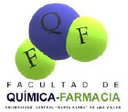Executive Secretary

7th International Chemistry Symposium
SIQ 2019
Cardiovascular and oncoploriferative diseases are the two leading causes of death in Cuba. The overexpression of the Angiotensin II Receptor Type 1 (AT1R) for this disease is reported; therefore, antagonists of this receptor labeled with 18F could be used as radiopharmaceuticals for diagnosis by Positron Emission Tomography (PET). In this work the stability, reactivity and coupling to the AT1R and the Human Serum Albumin (HSA) of three compounds of the Fluoroalkyl-Losartan family were evaluated. For stability and reactivity studies, Density Functional Theory was used with the level of theory M06-2X/6-311++G(2df,2p). The association with AT1R and HSA receptors was carried out with Autodock–Vina. Calculation of bond dissociation energy for each derivative determined that stability of compounds was: FML>FEL>FPL. The FEL was the compound with the lowest number of intramolecular interactions and the highest Area/Volume ratio. The Dual Descriptor showed that the phenyl ring adjacent to the tetrazole ring is the most probably zone for a nucleophilic attack and the imidazole ring for an electrophilic attack. All derivatives under study are very polar molecules and their acidity follows the order FPL≈FEL>FML>Losartan. Docking studies of components of the FAL family, with both the AT1R and HSA, suggest similarity for pharmacokinetic and pharmacodynamics properties with respect to Losartan; it was not possible, according to this parameter, to find within the FAL family the most optimal compound. The FML and FPL derivatives with similar values of thermodynamic stability, reactivity and equivalent association with AT1R are proposed as possible positronic radiopharmaceuticals discarding the FEL.
Cardiovascular and oncoploriferative diseases are the two leading causes of death in Cuba. The overexpression of the Angiotensin II Receptor Type 1 (AT1R) for this disease is reported; therefore, antagonists of this receptor labeled with 18F could be used as radiopharmaceuticals for diagnosis by Positron Emission Tomography (PET). In this work the stability, reactivity and coupling to the AT1R and the Human Serum Albumin (HSA) of three compounds of the Fluoroalkyl-Losartan family were evaluated. For stability and reactivity studies, Density Functional Theory was used with the level of theory M06-2X/6-311++G(2df,2p). The association with AT1R and HSA receptors was carried out with Autodock–Vina. Calculation of bond dissociation energy for each derivative determined that stability of compounds was: FML>FEL>FPL. The FEL was the compound with the lowest number of intramolecular interactions and the highest Area/Volume ratio. The Dual Descriptor showed that the phenyl ring adjacent to the tetrazole ring is the most probably zone for a nucleophilic attack and the imidazole ring for an electrophilic attack. All derivatives under study are very polar molecules and their acidity follows the order FPL≈FEL>FML>Losartan. Docking studies of components of the FAL family, with both the AT1R and HSA, suggest similarity for pharmacokinetic and pharmacodynamics properties with respect to Losartan; it was not possible, according to this parameter, to find within the FAL family the most optimal compound. The FML and FPL derivatives with similar values of thermodynamic stability, reactivity and equivalent association with AT1R are proposed as possible positronic radiopharmaceuticals discarding the FEL.
About The Speaker

Lic. Alejandro Martínez León






